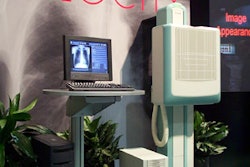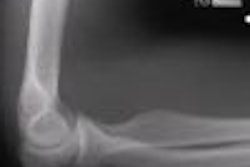CHICAGO - Pregnant women need not avoid diagnostic and interventional radiological procedures because of radiation concerns, U.K. investigators said Wednesday at the American Urological Association meeting.
Dr. Giles Hellawell and colleagues from the Churchill Hospital in Oxford reviewed the medical literature to assess the lethal, teratogenic, and carcinogenic risk to the developing fetus from radiation exposure. Hellawell is currently a resident at the Royal Free Hospital in London.
"The use of ionizing radiation is often avoided during pregnancy because exposure to ionizing radiation is thought to inevitably cause harm to the fetus," Hellawell, a urologist, said. "However, the radiation doses encountered in medical diagnostic imaging rarely exceed thresholds that can cause miscarriage, congenital malformation, and mental retardation. The main concern is thus the potential for radiation-induced cancer arising in childhood as a result of in utero irradiation."
To date, there have been few reports of typical radiation doses in urological investigations, and the risk of exposure to ionizing radiation is therefore unclear, he added.
Hellawell’s research showed that no single diagnostic x-ray procedure in routine urological practice involves radiation levels that can threaten the developing fetus. "Pregnancy should not be viewed as a contraindication to the use of diagnostic radiation exposure, provided that the level of exposure is appropriate," he said.
For the study, data were collected for a range of different urological radiological procedures and interventions. Specifically, the average effective dose to the patient and the uterus organ dose were calculated.
Results showed that for most urological investigations, the risk of catastrophic effects during pregnancy and cancer induction risks were very low. For example, women who underwent an unenhanced CT scan had uterine dosages of 17.7 mGy, significantly below the threshold 100-mGy dose at which adverse effects to the fetus have been recorded.
The doses for nephrostomy and intravenous urogram were, at 1.1 mGy and 1.8 mGy, respectively, also significantly below levels that might harm the fetus. Other radiological examinations included for comparison in the analysis were percutaneous nephrolithotomy, antegrade ureteric placement, uterine fibroid embolization, varicocele embolization, and chest x-ray.
As part of his study, Hellawell’s group reviewed the risk of radiation exposure during pregnancy as demonstrated by the management of loin pain associated with hydronephrosis during pregnancy.
In seven patients, a flexible cystoscope was used to identify the ureteric orifice, and permitted a guidewire to be inserted and passed into the renal pelvis under minimal fluoroscopic guidance with subsequent stent placement. Procedures were conducted under no anesthesia or limited anesthesia.
The use of fluoroscopy allowed ureteric stents to be placed safely and reliably, Hellawell said. Also, the average excess risk to the fetus from this procedure was 1 in 43,000 of cancer induction and 1 in 100,000 of heritable disease. The risk is therefore almost negligible compared to the incidence that occurs with natural background radiation, the authors concluded.
However, Hellawell emphasized that the exposure of a pregnant woman to radiation is indicated during pregnancy only for significant medical problems. And in his experience, radiation can be used sparingly with minimal fetal exposure while allowing a safer procedure.
"Even for a CT scan, which we would think might be anathema during pregnancy, we don’t really increase overall cancer induction risk that greatly," he said. "We are not saying that we should go out and irradiate pregnant patients. But we should be able to reassure women who may be inadvertently discovered to be pregnant during a scan that there is a low risk to the fetus and low risk of cancer induction."
By Jill SteinAuntMinnie.com contributing writer
May 1, 2003
Related Reading
Procedure-associated radiation exposure adds minimal risk in pregnancy, January 14, 2003
Radiotherapy for Wilms tumor raises pregnancy risks, May 28, 2002
Policy clarifies imaging risks for pregnant women, May 15, 2002
ICRP releases report on pregnancy and radiation, July 17, 2001
Copyright © 2003 AuntMinnie.com



















